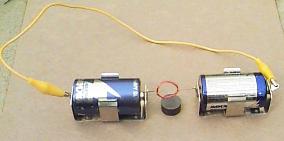 the two ends of the wire around
the coil so that it holds together well, and so that the two ends
of the wire are sticking out in opposite directions.
the two ends of the wire around
the coil so that it holds together well, and so that the two ends
of the wire are sticking out in opposite directions.
A coil of wire becomes an electromagnet when a current is flowing. Then the coil is attracted to a magnet or repelled by it. If the current is constant, the motion will stop when the magnet and coil get too close or too far away. To keep it turning, we need a switch that turns the current on and off. Here is how to make a motor, in which a turning coil and deliberately dirty contacts make the switch.
Assemble these materials:
Put batteries in a pair of battery holders, and put them in a line so that the positive end of one faces the negative end of the other. Leave a few cm of space between them.
Making the coil
 the two ends of the wire around
the coil so that it holds together well, and so that the two ends
of the wire are sticking out in opposite directions.
the two ends of the wire around
the coil so that it holds together well, and so that the two ends
of the wire are sticking out in opposite directions.

Place a stack of two cylindrical magnets magnets underneath the coil, and connect the free ends of the battery holders with a wire with clips on it. Give the coil a little nudge to get it turning. If the first nudge doesn't work, try to get it turning the other way. If the motor isn't running yet, turn the magnet stack over and try twice more (turning each way). If this still doesn't work, check that there is a current flowing some of the time, by adding a light bulb to the circuit, and check the alignment and balance of the coil.
We hope the motor works for you. Here is how it works: the marking ink is an insulator, so that the coil resting on the battery terminals has a current flowing when one side is up, but not when the other side is up. When the current is flowing, the coil is a magnet. If the cylinder magnets and the coil have opposite magnetic polarity, the magnetic interaction will cause the coil to turn over. This turns off the current and the magnetic interaction, so that the coil coasts through another half turn. The current turns back on about the time that the coil gets back to its original position -- and so it goes around and around and around.
Because magnetic interactions are easy to turn on and off like this, they are the most common way to turn electrical energy into motion. Almost every motor, stereo speaker, buzzer, door bell, relay, or electrical switch is based on magnetic interactions, and in many respects they are all near relatives to the little motor you have just made.
Check the box when you are
done:
Next:Inducing a voltage